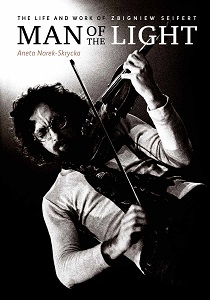Home » Jazz Articles » Book Review » Man Of The Light: The Life And Work Of Zbigniew Seifert
Man Of The Light: The Life And Work Of Zbigniew Seifert
 Man Of The Light: The Life And Work Of Zbigniew Seifert
Man Of The Light: The Life And Work Of Zbigniew Seifert Aneta Norek-Skrycka
172 Pages
ISBN: 978-83-938054-2-6
The Zbigniew Seifert Foundation
2016
A number of European jazz musicians stand out for having shaped the sound of the music in the past fifty years, for their virtuosity and for having influenced subsequent generations. A partial list would include Django Reinhardt, Joe Zawinul, Jan Garbarek, Jan Johansson, Norma Winstone, Henri Texier, Enrico Rava and Tomasz Stańko. A lesser known but equally worthy name is that of Zbigniew Seifert, the Polish violin virtuoso whose star shone brightly for a decade —in Stanko's first major quintet and leading his own ensembles—before he died of cancer in 1979, aged thirty two.
This welcome English translation of Aneta Norek-Skrycka's Seifert biography—published in Polish in 2009—relates the story of a singularly talented musician and a warm human being, whose unique approach to jazz violin won him admirers both at home and abroad. Seifert wasn't the first to be labelled the John Coltrane of the violin but he was arguably the most exciting and original violinist of his generation. "I have never heard anyone playing the violin like this before," McCoy Tyner told music journalist/author Joachim Brendt.
Other admirers of Seifert included John Scofield, Joachim Kuhn, Jan Hammer, Jack DeJohnette and Richie Beirach, to cite just a few. Valerie Wilmer, the renowned English jazz writer/photographer, found in Sefiert's playing at the Jazz Jamboree in 1970 "all that was really moving and inspiring in jazz." And of course Stanko, in whose first quintet Seifert played from 1968 to 1973, recording three albums. Seifert was, Stanko said in a 1979 interview, "the only musican whom I never had to explain anything to, because he already knew exactly what to do."
Norek-Skrycka's chronological, factual portrait of Seifert's life and works plays out during the Cold War, Communist years in Poland, though apart from learning that Seifert's father, Waclaw, was incarcerated by the authorities for a year, and that obtaining permission to travel abroad was both necessary and complicated, little sense of life in Poland under the Communist regime emerges from these pages.
Such historical backdrop was perhaps unnecessary to elaborate upon for readers of the Polish edition of the book, but the realities of life in Poland during that period are difficult to imagine for those in non-Communist, Western Europe. For this English edition of the book, deeper insight into what Norek-Skrycka describes as the "drab reality of Communist Poland" and "a world deprived of freedom" might have put Seifert's struggles and achievements—his dreams—in greater context.
Norek-Skrycka's narrative is neatly divided into five chapters: Seifert's childhood; his musical education; his first jazz ensemble; the Tomasz Stanko years; and finally, Seifert's international career. Testament comes from those who knew Seifert best, his family, musical colleagues and jazz journalists. The author draws heavily from Polish jazz magazines of the day such as Jazz and Jazz Forum to cast critical light on Seifert's recordings and live performances, but the one voice that is heard rather too infrequently is that of Seifert himself, who it appears, was not the subject of too many interviews during his career.
There are plenty of extracts from Seifert's letters to his parents from his sojourns abroad. Taken together, Seifert's correspondence portray a dedicated son, an ambitious musician and, following his cancer diagnosis, a selfless, caring individual who bravely shielded family from the reality of his illness for as long as he could. Not all the letters add to the narrative, however, and details of house hunting and the chores of decorating, or detailed travel itineraries, for example, seem superfluous.
Drawn to the violin at a very early age, Seifert's natural talent blossomed with an intense practise regime and he sailed through classical violin studies with top marks. The phenomenal technique that would frequently place Seifert in jazz polls alongside the likes of Stephane Grappelli, Jerry Goodman, Jean-Luc Ponty and Michal Urbaniak was honed in the Chopin State Secondary Music School under the tutelage of Stanislaw Tawroszewicz, to whom Seifert would later dedicate the song "Coral."
Once the jazz bug took hold, while still at school in Cracaw, there was no turning back and Seifert abandoned classical studies for good. In the mid-sixties, on alto saxophone, Seifert formed a jazz quartet with school friends Jan Jarczyk (piano), Jan Gonciarczyk (bass) and Janusz Stefanski (drums). The modern jazz of Miles Davis, Ornette Coleman and Herbie Hancock provided inspiration, though Seifert was particularly influenced by the "enormous importance" of Charles Lloyd and Coltrane.
Despite winning acclaim both home and abroad, Seifert's quartet never entered the studio, though a CD of the band's live festival appearances, Nora, was eventually released by GAD Records in 2010, almost forty years after the band's dissolution. For five years Seifert also played in Stanko's first quintet, gaining even greater international recognition as the band toured internationally.
A major turning point in Seifert's musical evolution, Norek-Skrycka relates, is when Seifert began to play jazz violin in 1971, a move inspired by encounters with modernists such as Don Cherry, Steve Lacy, Peter Brotzmann and Han Bennink and encouraged by Stanko and his bandmates. From the outset, we learn, Seifert's intention was to play violin the way Coltrane played saxophone. Not for nothing is it difficult to intuit the influence of any jazz violinists in Seifert's style.
Seifert's unorthodox approach produced exhilarating results. "His attack was incredible!" proclaimed Stefanski in a 1979 Jazz Forum interview. "The way he could grab the listener with the first note sent shivers down one's spine."
Seifert would disband his quartet in 1970 to focus solely on Stanko's quintet, though increasingly he was involved in side-projects, including those for Polish Radio Jazz Studio -an experimental laboratory of sorts that attracted Poland's top jazz talents. Stanko's quintet, however, came to a natural end in 1973: ..."all of us were longing for a different kind of music," Seifert recalled in a 1975 Jazz Forum interview.
The final chapter concentrates on Seifert's brief but brilliant international career. Relocating to Germany, Seifert immediately began working with Hans Koller's Free Sound, wrote a concerto for jazz violin and received invitations to collaborate with Charlie Mariano, Philip Catherine, John Surman and Larry Coryell, amongst others.
In just a few short years Seifert would play at the Montreux Jazz Festival, and at the Monterey Jazz Festival with the John Lewis Quartet and with the Toshiko Akiyoshi/Lew Tabackin Big Band, as well as leaving his mark in the studio with Oregon on Violin (Vanguard Records, 1978) and with Glen Moore on the bassist's first solo album.
Seifert also played in a duo with Albert Mangelsdorff, who commented: "Of all the musicians I can think of at the moment, Seifert is the one who appeals to me most."
Had Seifert signed for ECM instead of Capitol—the reasons for that decision are unstated—then the violinist's handful of recordings as leader would likely never have gone out of print. Norek-Skrycka's appraisal of Seifert's recorded output—drawn entirely from reviews of the day—hint sporadically at Sefiert's genius and at his debt to Coltrane. The absence of a complete discography for quick reference is a minor annoyance.
Critics, the author presents with an admirable sense of balance, were divided between huge admiration for Seifert's virtuosity and frustration at his idiom that shackled him closely to Coltrane. Man of the Light (MPS, 1977), which featured Billy Hart, Joachim Kuhn, Cecil McBee and Jasper Van't Hof, was arguably Seifert's finest hour, yet a Jazz Forum review bemoaned the Coltrane idolatry, hoping that for the next record Seifert might "look deeper inside himself."
Sadly, there was little time. Seifert's cancer diagnosis meant he had to turn down an offer to teach jazz violin at Berklee College of Music and in 1977 he spent fully eight months in hospital undergoing treatment. Although Seifert briefly rallied, the concerts in November 1978 were to be his last. This part of the book dealing with Seifert's courageous battle against cancer—with his wife Agnieszka beside him very step of the way—is perhaps the most revealing part of Norek-Skrycka's portrait of a musician destined for greatness but stopped cruelly short.
An obvious omission from this edition of the book is a study of Seifert's legacy today, in Poland and abroad. Established jazz violinists such as Zach Brock and up-and-coming violinists like Tomoko Omura owe a significant debt to Seifert. Likewise, Polish jazz violinists from Adam Baldych and Stanislaw Slowinski to David Lubowicz and Bartosz Dworak have also been inspired, to greater or lesser degree, by Seifert.
Nor is there any mention of the bi-annual Zbigniew Seifert International Jazz Violin Competition, founded in 2014 by Małgorzata Jantos, which attracts the world's best up-and-coming jazz violinists to Poland, thus helping to keep the fires of Seifert's legacy burning brightly.
Future editions of the book might benefit by bringing Seifert's ongoing story up to date.
Norek-Skrycka's painstakingly researched and well-illustrated Seifert biography—complete with an accompanying CD of a never-before-released recording of Seifert with Richie Beirach—will make for essential reading for fans of the Polish violinist, who first made his mark on European jazz almost half a century ago.
Man of the Light..., however, should also appeal more broadly to those jazz historians eager to plug gaps in the still-unfolding historical narrative of European jazz. And, for the plain curious, Norek-Skrycka's book serves as a pretty comprehensive introduction to the relatively unsung, yet undoubtedly brilliant virtuoso that was Zbigniew Seifert.
< Previous
Blue And Lonesome
Comments
About Zbigniew Seifert
Instrument: Violin
Related Articles | Concerts | Albums | Photos | Similar ToTags
zbigniew seifert
Book Reviews
Ian Patterson
Poland
Wroclaw
Django Reinhardt
Joe Zawinul
Jan Garbarek
Jan Johansson
norma winstone
Henri Texier
Enrico Rava
tomasz stanko
John Coltrane
McCoy Tyner
John Scofield
Joachim Kühn
Jan Hammer
Jack DeJohnette
Richie Beirach
Stephane Grappelli
Jerry Goodman
Jean-Luc Ponty
Michal Urbaniak
Janusz Stefanski
Miles Davis
Ornette Coleman
Herbie Hancock
charles lloyd
Don Cherry
Steve Lacy
Peter Brotzmann
Han Bennink
Charlie Mariano
Philip Catherine
John Surman
Larry Coryell
John Lewis
Toshiko Akiyoshi
lew tabackin
Oregon
Glen Moore
Albert Mangelsdorff
Billy Hart
cecil mcbee
Jasper Van't Hof
Zach Brock
tomoko omura
Adam Baldych
Bartosz Dworak
For the Love of Jazz
 All About Jazz has been a pillar of jazz since 1995, championing it as an art form and, more importantly, supporting the musicians who create it. Our enduring commitment has made "AAJ" one of the most culturally important websites of its kind, read by hundreds of thousands of fans, musicians and industry figures every month.
All About Jazz has been a pillar of jazz since 1995, championing it as an art form and, more importantly, supporting the musicians who create it. Our enduring commitment has made "AAJ" one of the most culturally important websites of its kind, read by hundreds of thousands of fans, musicians and industry figures every month.
























